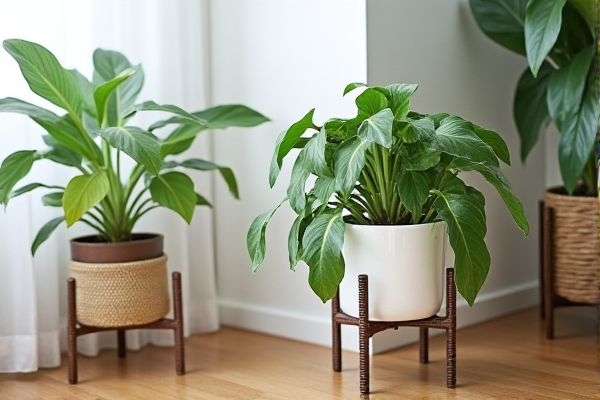
Plant caddies offer mobility with wheels to easily move heavy pots, while plant stands elevate your greenery for better display and drainage. Discover which option suits Your indoor gardening needs by reading the rest of the article.
Table of Comparison
| Feature | Plant Caddy | Plant Stand |
|---|---|---|
| Primary Use | Easy movement of potted plants | Elevating plants for display and decor |
| Material | Plastic, wood, metal with wheels | Wood, metal, rattan, ceramic |
| Mobility | Equipped with caster wheels for rolling | Stationary, no wheels |
| Design | Low-profile, functional | Decorative, variety of styles |
| Weight Capacity | Supports heavy pots, depends on material | Varies widely, designed for display weight |
| Indoor/Outdoor Use | Ideal for both, weather-resistant options available | Commonly indoor; some outdoor models |
Introduction to Plant Caddies and Plant Stands
Plant caddies are wheeled platforms designed to easily move potted plants, enhancing mobility and convenience for indoor and outdoor gardening. Plant stands provide stable, elevated surfaces to display plants, improving aesthetics and ensuring proper air circulation around the pot. Both accessories serve distinct purposes, with caddies focusing on mobility and stands emphasizing presentation and plant health.
What is a Plant Caddy?
A plant caddy is a wheeled platform designed to easily move heavy pots and planters without lifting, protecting floors from scratches and water damage. Unlike a plant stand, which elevates plants for display and airflow, a caddy prioritizes mobility and convenience, making it ideal for repositioning your plants indoors or outdoors. Your choice depends on whether you need easy transport or aesthetic elevation for your greenery.
What is a Plant Stand?
A plant stand is a decorative and functional piece of furniture designed to elevate pots and planters off the ground, enhancing the display of indoor or outdoor plants. Typically made from materials like wood, metal, or plastic, plant stands vary in height and style to complement different interior designs while providing better air circulation and light exposure for the plants. Unlike plant caddies, which are primarily mobile bases with wheels, plant stands focus on aesthetics and plant presentation without mobility features.
Key Differences Between Plant Caddies and Plant Stands
Plant caddies are typically designed with wheels to provide mobility for heavy pots, whereas plant stands offer elevated platforms that enhance plant display and support. Plant caddies are usually low-profile and built to fit under pots, focusing on ease of movement, while plant stands come in various heights and styles aimed at aesthetic presentation. Material variations also distinguish them, as caddies often use robust materials like metal or plastic for durability, whereas stands may incorporate decorative wood or wrought iron elements.
Benefits of Using a Plant Caddy
A plant caddy offers enhanced mobility by allowing you to easily move heavy pots for cleaning or rearranging without straining your back. It helps protect your floors from water damage and dirt while providing better airflow underneath the plant, promoting healthier root systems. You can efficiently manage your indoor garden with minimal effort by using a plant caddy, ensuring your plants thrive in any room.
Advantages of a Plant Stand
A plant stand offers superior stability and height customization, making it ideal for showcasing your plants indoors or outdoors. Unlike plant caddies, stands elevate plants off the ground, enhancing air circulation and preventing water damage to flooring. Your plants benefit from improved exposure to light and better aesthetic presentation on a plant stand.
Ideal Uses for Plant Caddies
Plant caddies are ideal for indoor or outdoor plants that require frequent repositioning for optimal sunlight, watering, or cleaning, providing smooth mobility on hard floors or patios. They prevent damage to flooring by distributing the plant's weight evenly while allowing easy drainage and airflow beneath pots. Their low-profile design suits heavy or large pots, making them perfect for gardeners seeking convenience and floor protection.
Best Situations for Plant Stands
Plant stands are ideal for elevating greenery in small spaces, allowing better light exposure and airflow for indoor plants. They work well in living rooms, balconies, or offices where plants need to be showcased at varying heights to create visual interest. Their sturdy construction supports heavy pots, making them suitable for larger plants that require stability.
Plant Caddy vs Plant Stand: Which Should You Choose?
A plant caddy offers mobility with wheels or casters, making it ideal for indoor plants that require frequent repositioning for light or cleaning purposes. In contrast, a plant stand provides a stable, elevated display, enhancing the aesthetic appeal by showcasing plants at varying heights and often complementing interior decor. Choosing between a plant caddy and a plant stand depends on whether ease of movement or decorative presentation is your primary goal.
Conclusion: Making the Right Choice for Your Plants
Choosing between a plant caddy and a plant stand depends on your space, mobility needs, and aesthetic preferences. Plant caddies offer easy mobility with wheels, ideal for heavy pots and frequent repositioning, while plant stands provide elevated display and style, enhancing plant visibility and decor. Assess your plant care routine and interior design to make the best functional and visual decision for your greenery.
 homyna.com
homyna.com